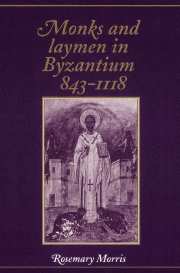Book contents
- Frontmatter
- Contents
- List of maps
- List of tables
- Acknowledgements
- Note on transliteration and citation
- List of abbreviations
- Introduction
- PART I FOUNDERS AND BENEFACTORS
- PART II PROTECTION AND SURVIVAL
- 6 Monasteries and the law
- 7 Fortune and misfortune
- 8 Territorial expansion and spiritual compromise
- 9 The challenge to central authority
- 10 The Komnene reaction
- Appendix: Imperial privileges to monasteries, c. 900–1118
- Bibliography
- Index
6 - Monasteries and the law
from PART II - PROTECTION AND SURVIVAL
Published online by Cambridge University Press: 10 December 2009
- Frontmatter
- Contents
- List of maps
- List of tables
- Acknowledgements
- Note on transliteration and citation
- List of abbreviations
- Introduction
- PART I FOUNDERS AND BENEFACTORS
- PART II PROTECTION AND SURVIVAL
- 6 Monasteries and the law
- 7 Fortune and misfortune
- 8 Territorial expansion and spiritual compromise
- 9 The challenge to central authority
- 10 The Komnene reaction
- Appendix: Imperial privileges to monasteries, c. 900–1118
- Bibliography
- Index
Summary
While donation and endowment played a crucial rôle in the establishment of monastic houses, their survival for more than a few years was governed by other factors than the devotion of their founders and the enthusiasm of their immediate patrons. The most important of these was the legal status enjoyed by monastic lands which was the basis of all future prosperity. Without proper legal title to their lands, houses could be deprived of the most useful of their assets – property. Without estates, monasteries could not hope to survive, for both food supply and revenue depended not merely on possession of land, but on a territory adequate to the needs of each house. The safeguarding of their landed endowments and subsequent acquisitions was thus a matter of supreme concern to monastic landowners and the strongest weapon at their disposal was that of the law. Legal precedents were cited to protect and confirm existing territorial conditions, charters were scrupulously reconfirmed at every change of imperial régime, and court cases over disputed lands and rights were a commonplace of monastic life in the larger houses.
In the course of the tenth and eleventh centuries, the conditions under which monastic lands might be held became increasingly complex. This complexity was matched by the evolution of a vast array of terminology which expressed every possible nuance of the legal rights of possession, donation and management.
- Type
- Chapter
- Information
- Monks and Laymen in Byzantium, 843–1118 , pp. 145 - 165Publisher: Cambridge University PressPrint publication year: 1995



